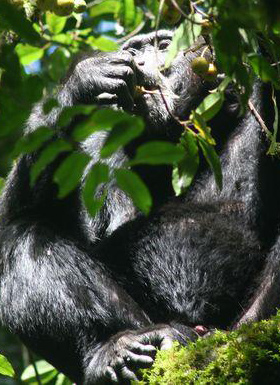Dirt-munching helps protect chimps from malaria
Dirt-munching helps protect chimps from malaria
mongabay.com
January 10, 2008
|
|
Soil ingestion helps chimps protect themselves from malaria, reports a new study published in the journal Naturwissenschaften. Apparently geophagy, as the deliberate behavior is known, “increases the potency of ingested plants with anti-malarial properties.”
The health effects of leaves consumed in combination with soil by chimpanzees in the Kibale National Park in Uganda, Sabrina Krief and colleagues found that digested leaves of Trichilia rubescens showed no significant anti-malarial activity when eaten alone. However, when the leaves and soil were digested together, the combination had distinct anti-malarial properties. Further, the researchers found the same soil is used by local people for treating diarrhea.
 Wild chimp in Uganda’s Kibale forest. Photo by Rhett A. Butler |
“The researchers also compared the composition of the soil eaten by chimpanzees with the content of soil used by the local healer to treat diarrhea amongst his patients,” explained a statement from Springer, publisher of Naturwissenschaften. “All the soil samples were rich in the clay mineral kaolinite, the principal component of some anti-diarrheal medicines. Furthermore, samples used by chimps and humans had exactly the same external aspects, were collected in a similar place and show a comparable physical and chemical profile, indicating similar content.”
“This overlapping use by humans and apes is interesting from both evolutionary and conservation perspectives – saving apes and their forests is also important for human health,” said lead author Krief.
Geophagy has been observed in other species as well. In the Amazon, macaws and other parrots consume clay to detoxify the seeds they eat.
Krief S, Klein N & Fröhlich F (2008). Geophagy: soil consumption enhances the bioactivities of plants eaten by chimpanzees. Naturwissenschaften (DOI 10.1007/s00114-007-0333-0)